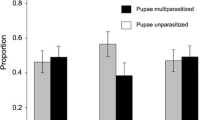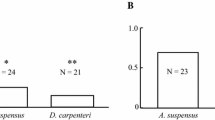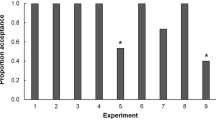Abstract
Intraspecific host discrimination is frequently found in solitary parasitoids, but interspecific host discrimination, where female parasitoids recognize hosts already parasitized by females of other species, is rare. This particular behaviour appears to be adaptive only under specific circumstances. In this paper, we quantified intraspecific host discrimination in Anaphes n. sp. (Hymenoptera: Mymaridae), an endoparasitoid of the eggs of Listronotus oregonensis (LeConte) (Coleoptera: Curculionidae) and interspecific host discrimination toward eggs parasitized by Anaphes sordidatus (Girault), a sympatric species competing for the same resource in similar habitats. To examine host discrimination, choice experiments were used where the females had to choose between different categories of eggs (unparasitized, parasitized by Anaphes n. sp. or A. sordidatus). Superparasitism and multiparasitism were avoided in experiments where the female had a choice between unparasitized hosts and hosts parasitized by the same female, by a conspecific or by a female A. sordidatus. When all hosts available were parasitized, conspecific superparasitism occurred more often than self-superparasitism or multiparasitism. These results indicated that females Anaphes n. sp. were capable of self-, conspecific and interspecific discrimination. Self-discrimination followed recognition of an external marking while interspecific discrimination occurred mostly after insertion of the ovipositor. Interspecific discrimination could result from the recent speciation of these species and could be associated with a genotypic discrimination. This behavior appears to be adaptive because of the competition for common hosts between the two parasitoid species.
Similar content being viewed by others
References
Alphen JJM van, Nell HW (1982) Superparasitism and host discrimination by Asobara tabida (Braconidae, Alysiinae), larval parasitoid of Drosolophilidae. Neth J Zool 32: 232–260
Alphen JJM van, Vet LEM (1986) An evolutionary approach to host finding and selection. In: Waage J, Greathead D (eds) Insect parasitoids. Academic Press, London, pp 23–61
Alphen JJM van, Visser ME (1990) Superparasitism as an adaptive strategy for insect parasitoids. Annu Rev Entomol 35: 59–79
Baaren J van (1994) Capacité discriminatoire, installation et régulation du superparasitisme chez les Hyménoptères parasitoïdes: analyse expérimentale. Thèse de doctorat de l'Université de Rennes I
Bakker K, Alphen JJM van, Batenburg FHD van, Hoeven N van der, Nell HW, Strien-van Liempt WTFH van, Turlings TJC (1985) The function of host discrimination and superparasitization in parasitoids. Oecologia 67: 572–576
Boivin G (1988) Laboratory rearing of Anaphes sordidatus (Girault) (Hymenoptera: Mymaridae) on carrot weevil eggs (Coleoptera: Curculionidae). Entomophaga 33: 131–134
Boivin G (1993) Density dependence of Anaphes sordidatus (Hymenoptera: Mymaridae) parasitism on eggs of Listronotus oregonensis (Coleoptera: Curculionidae). Oecologia 93: 73–79
Boivin G, van Baaren J, Nénon JP (1994) Learning affects how Anaphes n. sp. discriminates (Hymenoptera: Mymaridae). Norv J Agric Sci Suppl 16: 392–393
Bolter CJ, Laing JE (1983) Competition between Diadegma insulare (Hymenoptera: Ichneumonidae) and Microplitis plutellae (Hymenoptera: Braconidae) for larvae of the diamondback moth, Plutella xylostella (Lepidoptera: Plutellidae). Proc Entomol Soc Ont 114: 1–10
Charnov EL (1976) Optimal foraging, the marginal value theorem. Theor Popul Biol 9: 129–136
Chow FJ, Mackauer M (1986) Host discrimination and larval competition in the aphid parasitoid Ephedrus californicus. Entomol Exp Appl 41: 243–254
Collins RD, Grafius E (1986) Biology and life cycle of Anaphes sordidatus (Hymenoptera: Mymaridae), an egg parasitoid of the carrot weevil (Coleoptera: Curculionidae). Environ Entomol 15: 100–105
Guillot FS, Vinson SB (1972) The role of the calyx and poison gland of Cardiochiles nigriceps in the host-parasitoid relationship. J Insect Physiol 18: 1315–1321
Hagvar EB, Hofsvang T (1988). Interspecific competition between the aphid parasitoids Aphidius colemani Viereck and Ephedrus cerasicola Stary (Hymenoptera: Aphidiidae). Entomol Exp Appl 59: 145–150
Hubbard SF, Marris G, Reynolds A, Rowe GW (1987). Adaptive patterns in the avoidance of superparasitism by solitary parasitic wasps. J Anim Ecol 56: 387–401
Landry BS, Dextrase L, Boivin G (1993) Random amplified polymorphic DNA markers for DNA fingerprinting and genetic variability assessment of minute parasitic wasp species (Hymenoptera: Mymaridae and Trichogrammatidae) used in biological control programs of phytophagous insects. Genome 36: 580–587
Lenteren JC van (1976) The development of host discrimination and the prevention of superparasitism in the parasite Pseudeucoila bochei Weld (Hym.: Cynipidae). Neth J Zool 26: 1–13
Lenteren JC van (1981) Host discrimination by parasitoids. In: Nordlung DA, Jones RL, Lewis WJ (eds). Semiochemicals: their role in pest control. Wiley, New York, pp 153–179
Leveque L, Monge, JP, Rojas-Rousse D, Alebeek F van, Huignard H (1993) Analysis of multiparasitism by Eupelmus vuilleti (Craw) (Eupelmidae) and Dinarmus basalis (Rond) (Pteromalidae) in the presence of one of their common hosts, Bruchidius atrolineatus (Pic) (Coleoptera Bruchidae). Oecologia 94: 272–277
Mackauer M (1990) Host discrimination and larval competition in solitary endoparasitoids. In: Mackauer M, Ehler LE, Roland J (eds) Critical issues in biological control. Intercept/VCH, Andover, pp 41–62
McBrien H, Mackauer M (1991) Decision to superparasitize based on larval survival: competition between aphid parasitoids Aphidius ervi and Aphidius smithi. Entomol Exp Appl 59: 145–150
Picard C, Auclair JL, Boivin G (1991) Response to host age of the egg parasitoid Anaphes n.sp. (Hymenoptera: Mymaridae). Biocontrol Sci Tech 1: 169–176
Rabb RL, Bradley JR (1970) Marking host eggs by Telenomus sphingis. Ann Entomol Soc Am 63: 1053–1056
Scholz D, Höller C (1992) Competition for hosts between two hyperparasitoids of aphids, Dendrocerus laticeps and Dendrocerus carpenteri (Hymenoptera: Megaspilidae): the benefit of interspecific host discrimination. J Insect Behav 5: 289–300
Strand MR, Godfray HCJ (1989) Superparasitism and ovicide in parasitic Hymenoptera: theory and a case study of the ectoparasitoid Bracon hebetor. Behav Ecol Sociobiol 24: 421–432
Strien-van Liempt WTFH van, Alphen JJM van (1981) The absence of interspecific host discrimination in Asobara tabida Nees and Leptopilina heterotoma (Thompson) coexisting larval parasitoids of Drosophila species. Neth J Zool 31: 701–712
Turlings TCJ, Batenburg FHD van, Strien-van Liempt WTFH van (1985) Why is there no interspecific host discrimination in the two coexisting larval parasitoids of Drosophila species, Leptopilina heterotoma (Thompson) and Asobara tabida (Nees). Oecologia 67: 352–359
Vet LEM, Meyer M, Bakker K, Alphen JJM van (1984) Intra- and interspecific host discrimination in Asobara tabida (Hymenoptera) larval endoparasitoids of Drosophilidae: comparison between closely related and less closely related species. Anim Behav 32: 871–874
Vinson SB, Ables JR (1980) Interspecific competition among endoparasitoids of tobacco budworm larvae (Lep.: Noctuidae). Entomophaga 25: 357–362
Visser ME (1993) Adaptative self- and conspecific superparasitism in the solitary parasitoid Leptopilina heterotoma (Hymenoptera: Eucoilidae). Behav Ecol 4: 22–28
Visser ME, Alphen JJM van and Nell HW (1990) Adaptative superparasitism and patch time allocation in solitary parasitoids: the influence of the number parasitoids depleting a patch. Behaviour 114: 21–36
Visser ME, Luyckx B, Nell HW, Boskamp GJF (1992) Adaptative superparasitism and patch time allocation in solitary parasitoids: marking of parasitized hosts in relation to the pay-off from superparasitism. Ecol Entomol 17: 76–82
Völkl W, Mackauer M (1990) Age specific pattern of host discrimination by the aphid parasitoid Ephedrus californicus Baker (Hymenoptera: Aphidiidae). Can Entomol 122: 349–361
Wajnberg E, Pizzol J, Babault M (1989) Genetic variation in progeny allocation in Trichogramma maidis. Entomol Exp Appl 53:177–187
Zhao DX, Boivin G, Stewart RK (1991) Simulation model for the population dynamics of the carrot weevil, Listronotus oregonensis (LeConte) (Coleoptera: Curculionidae). Can Entomol 123: 63–76
Author information
Authors and Affiliations
Rights and permissions
About this article
Cite this article
van Baaren, J., Boivin, G. & Nénon, JP. Intra- and interspecific host discrimination in two closely related egg parasitoids. Oecologia 100, 325–330 (1994). https://doi.org/10.1007/BF00316961
Received:
Accepted:
Issue Date:
DOI: https://doi.org/10.1007/BF00316961




